This document discusses modeling the total cost of preservation (TCP) for digital assets over long periods of time. It presents a framework that breaks preservation activities down into 10 categories that each represent a cost component, such as content owners, submission streams, servers, storage, and more. The framework is based on the OAIS reference model but modified for broader applicability. The document makes assumptions to make the TCP analysis tractable, such as considering only costs of preservation providers. It provides a formula to calculate the TCP that sums the costs of each component category over the life of digital assets.
![Cost and Price Modeling for Sustainable Services Page 1 of 26
Total Cost of Preservation (TCP)
Cost and Price Modeling for Sustainable Services
Rev. 2.2.1 – 2014‐03‐11
Copyright © 2014 by The Regents of the University of California
This work is licensed under the terms of the Creative Commons Attribution‐ShareAlike 3.0 license
1 Introduction
Information technology and resources are thoroughly integrated with, and indispensable
to, today’s web‐based commerce, science, education, and entertainment. The digital
assets underpinning these activities, however, are inherently fragile with respect to ever
increasing disruptive technological change. Without effective, affordable, and proactive
curation management, today’s digital assets will not remain viable and useful in the
future. In order to sustain long‐term preservation efforts and results, the total cost of
preservation (TCP), that is, the full economic costs of preservation activities over archival
timespans, must be well understood. The University of California Curation Center (UC3)
[31] at the California Digital Library (CDL) [8], is engaged in the application of a TCP model
in order to move many of its core service offerings to a cost recovery operational basis. A
robust cost model is a necessary pre‐condition for the development of a sustainable
pricing scheme.
TCP analysis can be applied usefully in the development of two specific price models for
preservation service pricing:
Pay‐as‐you‐go
Paid‐up
The pay‐as‐you‐go model is appropriate for situations where a reliable and predictable
annual income stream is available to the client purchasing preservation services. When
this is not the case, for example, with organizations facing irregular/boom‐or‐bust
budgetary cycles or for fixed term, grant‐funded research projects, the paid‐up model
may be more attractive; indeed, in many circumstances it may be the only realistic
option.
2 Cost and price modeling
Long‐term digital preservation is a complex activity, involving sophisticated technical
infrastructure as well as significant human competencies, analysis, and decision making.](https://image.slidesharecdn.com/xdtlxncersk4mrjbpvmz-140520031556-phpapp02/75/Tcp-cost-price-modeling-for-sustainable-services-v2-2-1-1-2048.jpg)
![UC Curation Center (UC3) California Digital Library (CDL)
Cost and Price Modeling for Sustainable Service Page 2 of 26
Given the difficulties in accounting for the myriad aspects of preservation activity, and of
projecting the cost of those activities into the indefinite future, any analysis of TCP must
rely on a number of fundamental abstractions and assumptions about those activities and
the environment in which they take place. (See Appendix A for a summary of prior work
on preservation cost analysis.)
2.1 Preservation landscape
The TCP analytical framework abstracts preservation activities and their environment into
the following 10 high‐level categories, each of which is a cost component in TCP
modeling:
1. Content Owners (or Creators or Curators), with primary intellectual and
administrative stewardship responsibility for digital content Collections, use …
2. Submission Streams to send content to a …
3. Preservation System, with a primary technical stewardship responsibility,
composed of Ingest, Data management, and Access service functions, all
running on …
4. Servers and making use of …
5. Storage, to enable discovery and exploitation by …
6. Content Consumers (or Users), with ongoing …
7. Preservation Analysis and planning and …
8. Interventions as necessary to ensure ongoing viability
and accessibility, all subject to …
9. Direct operational Administration and …
10. High‐level Management oversight.
This abstraction (see Figure 1) is based on the ISO 14721 Open Archival Information
System (OAIS) reference mode [18], which is widely used within the digital library and
preservation communities. (More information about OAIS is found in Appendix F.)
However, the model and some of its terminology have been modified slightly in order to
broaden its applicability and facilitate understanding by a non‐specialist audience. (For
example, the OAIS producer entity has been replaced with owner.) With appropriate
definitional adjustment, the TCP model should be applicable to any online information
service.](https://image.slidesharecdn.com/xdtlxncersk4mrjbpvmz-140520031556-phpapp02/75/Tcp-cost-price-modeling-for-sustainable-services-v2-2-1-2-2048.jpg)
![UC Curation Center (UC3) California Digital Library (CDL)
Cost and Price Modeling for Sustainable Service Page 3 of 26
Each of these 10 categories can be further refined into subsidiary costs: capital and
operational expenses (CAPEX/OPEX); fixed and marginal expenses; one‐time, term, and
annual expenses; etc. The full set of hierarchical categories can be examined in the
accompanying spreadsheet that implements the TCP pay‐as‐you‐go and paid‐up price
models [32]. The spreadsheet is fully parameterized to allow other institutions and
service providers to incorporate appropriate assumptions and costs based on local policy
decisions.
Figure 1 – TCP entities and interactions
A content Owner or Curator is an individual or corporate agent with primary intellectual
stewardship responsibility for that body of content; the technical stewardship
responsibility rests with the preservation System.
A submission Stream is the technical mechanism, and its accompanying workflow, used
by Owners to transfer digital content to the preservation System.
A preservation Intervention is a non‐routine, non‐periodic, or unpredictable activity, such
as a format migration, necessary to ensure ongoing access to content managed within the
preservation System.
2.2 Assumptions
Properly accounting for the full economic costs of long‐term preservation is a complicated](https://image.slidesharecdn.com/xdtlxncersk4mrjbpvmz-140520031556-phpapp02/75/Tcp-cost-price-modeling-for-sustainable-services-v2-2-1-3-2048.jpg)
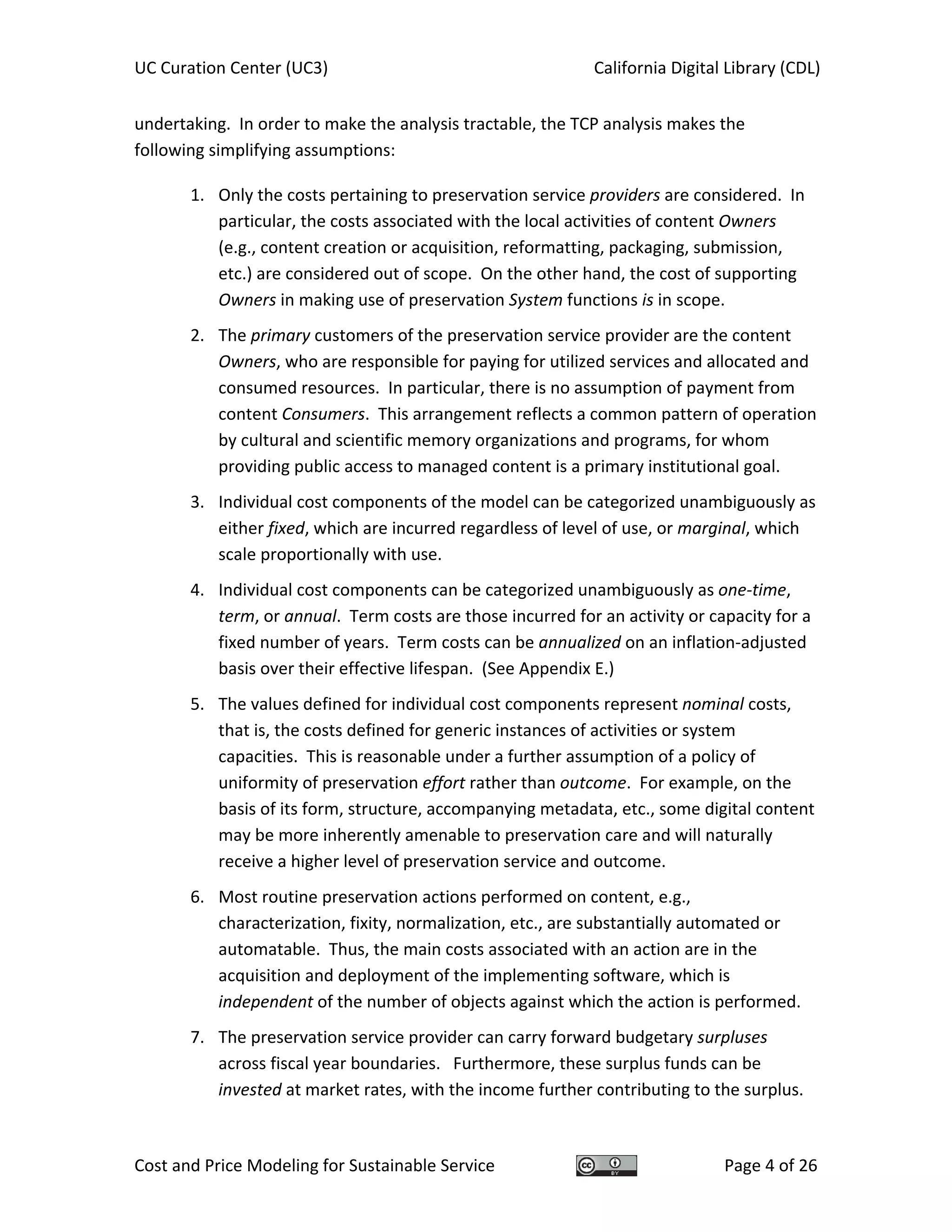
![UC Curation Center (UC3) California Digital Library (CDL)
Cost and Price Modeling for Sustainable Service Page 5 of 26
8. The model is ultimately revenue neutral, that is, there should be no surplus (or
deficit) funds remaining at the end of the period under consideration.
9. Values can be determined for various annual adjustment factors, such as
inflation, investment rate of return, cost of living adjustments (COLA), merit
pay raises, changes to the per‐unit cost of preservation, etc., which, although
held constant over the full period of TCP consideration, are nevertheless
reliably predictive of long‐term economic, technological, and organizational
trends.
The last assumption, although the mainstay of the standard economic forecasting
technique of discounted cash flow (DCF) analysis [10], can be problematic over extended
time periods.
2.2 Total cost of preservation
The total cost of preservation (TCP) to a preservation service provider across all of its
content Owners is represented numerically as:
· · ℓ · · · · (1)
where:
Total cost of preservation (incurred by the service provider across
all Owners).
Number of content Owners or Creators.
Unit cost of an Owner or Creator.
Number of unique submission Streams.
Unit cost of a Stream.
Fixed cost of the preservation System.
ℓ Number of Servers.
Unit cost of a Server.
Number of units of Storage.
Unit cost of Storage.
Number of content Consumers.
Unit cost of a Consumer.
Fixed cost of Analysis and Planning.
Number of preservation Interventions.
Unit cost of an Intervention.
Fixed cost of Administration.](https://image.slidesharecdn.com/xdtlxncersk4mrjbpvmz-140520031556-phpapp02/75/Tcp-cost-price-modeling-for-sustainable-services-v2-2-1-5-2048.jpg)
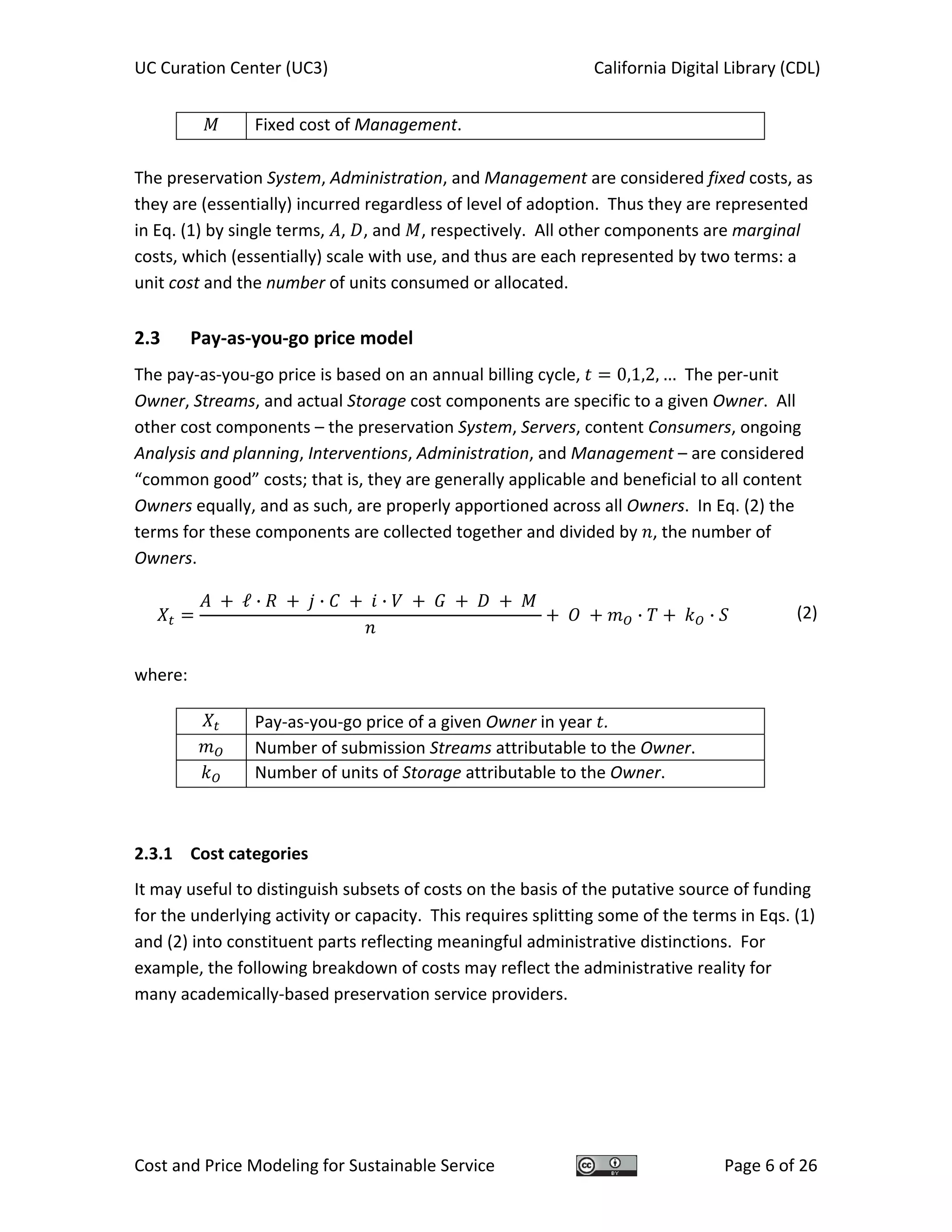
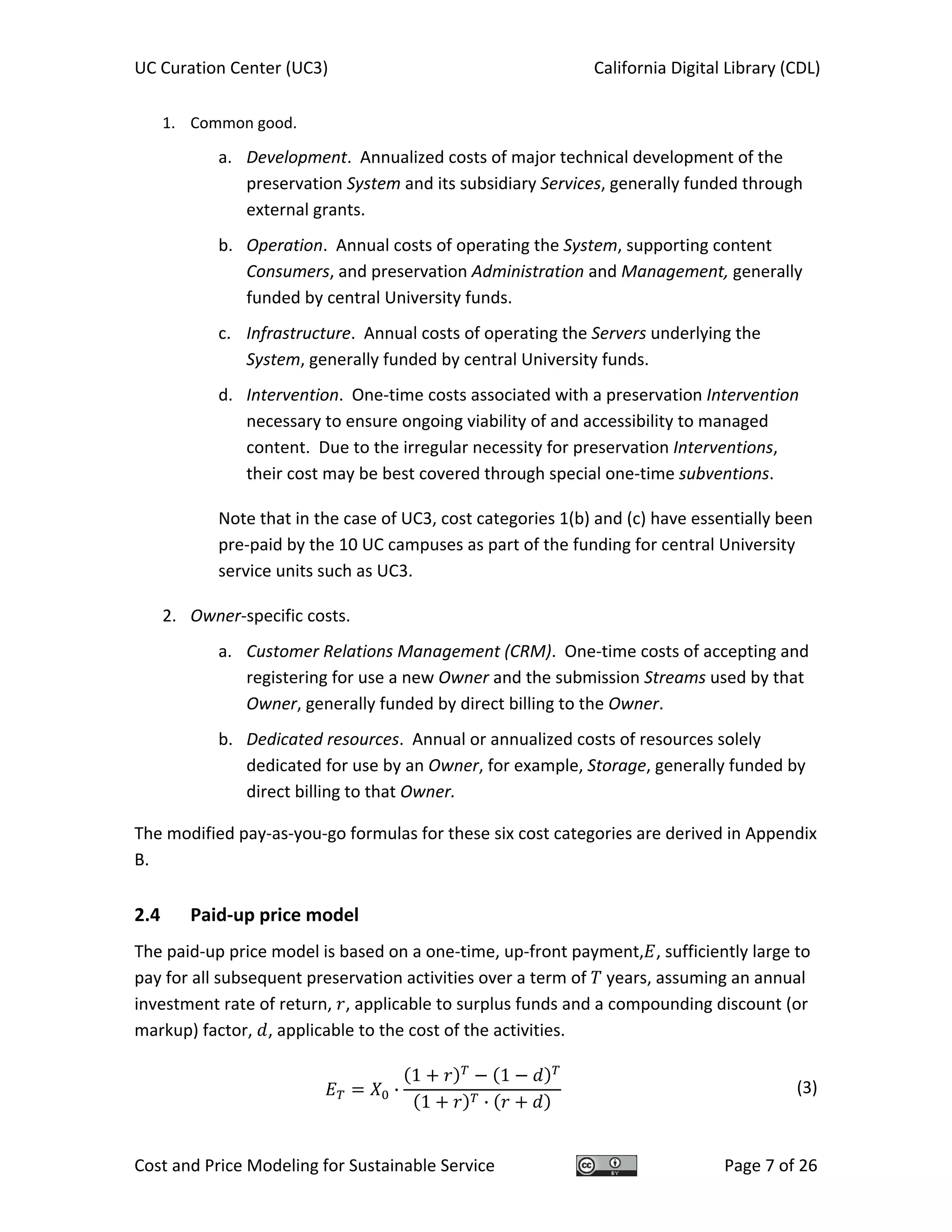
![UC Curation Center (UC3) California Digital Library (CDL)
Cost and Price Modeling for Sustainable Service Page 8 of 26
where:
Paid‐up price for years.
Pay‐as‐you‐go price established for the base year 0.
Investment rate of return, as a decimal (2% = 0.02).
Discount (or markup) factor, as a decimal.
Term, in years.
See Appendix C for the derivation of Eq. (3).
The determination of the annual discount/markup factor, , is highly dependent on the
nature of the underlying cost component. It may be useful to assign a different factor to
each of the cost categories defined in Section § 2.3.1, based on the following
assumptions:
1. The cost of staff‐dependent components, for example, Owner and Consumer CRM
(customer relationship management) and Analysis and planning, tends to increase
over time on the basis of staff cost‐of‐living (COLA) and merit salary increases,
although this increase may be mitigated by increases in staff productivity resulting
from improved tools and techniques.
2. The cost of infrastructure‐dependent components, for example, Servers and
Storage, tends to decrease over time, at least is has historically through steady
increases in semiconductor and storage media density, as expressed through the
well‐known Moore’s law [17] and Kryder’s law [35].
A modification to Eq. (8) incorporating distinct discount factors is derived in Appendix C.
The TCP paid‐up cost model is based on the economic forecasting technique of
discounted cash flow (DCF) [10]. Its predictive reliability is highly dependent on the values
specified for and . In general, the longer the term , the more difficult it is to estimate
values for and that will accurately reflect changing economic and technological trends
over years. In light of this, UC3 uses 10 as the maximum paid‐up term. See [1] and
[28] for alternative stochastic modeling approaches.
It is desirable for an Owner to be able to switch easily between the pay‐as‐you‐go and
paid‐up price basis. The relevant factor in this transition is the “coefficient of
persistence,” the one time premium or multiplier of the then current pay‐as‐you‐go price
to achieve paid‐up persistence for years.](https://image.slidesharecdn.com/xdtlxncersk4mrjbpvmz-140520031556-phpapp02/75/Tcp-cost-price-modeling-for-sustainable-services-v2-2-1-8-2048.jpg)

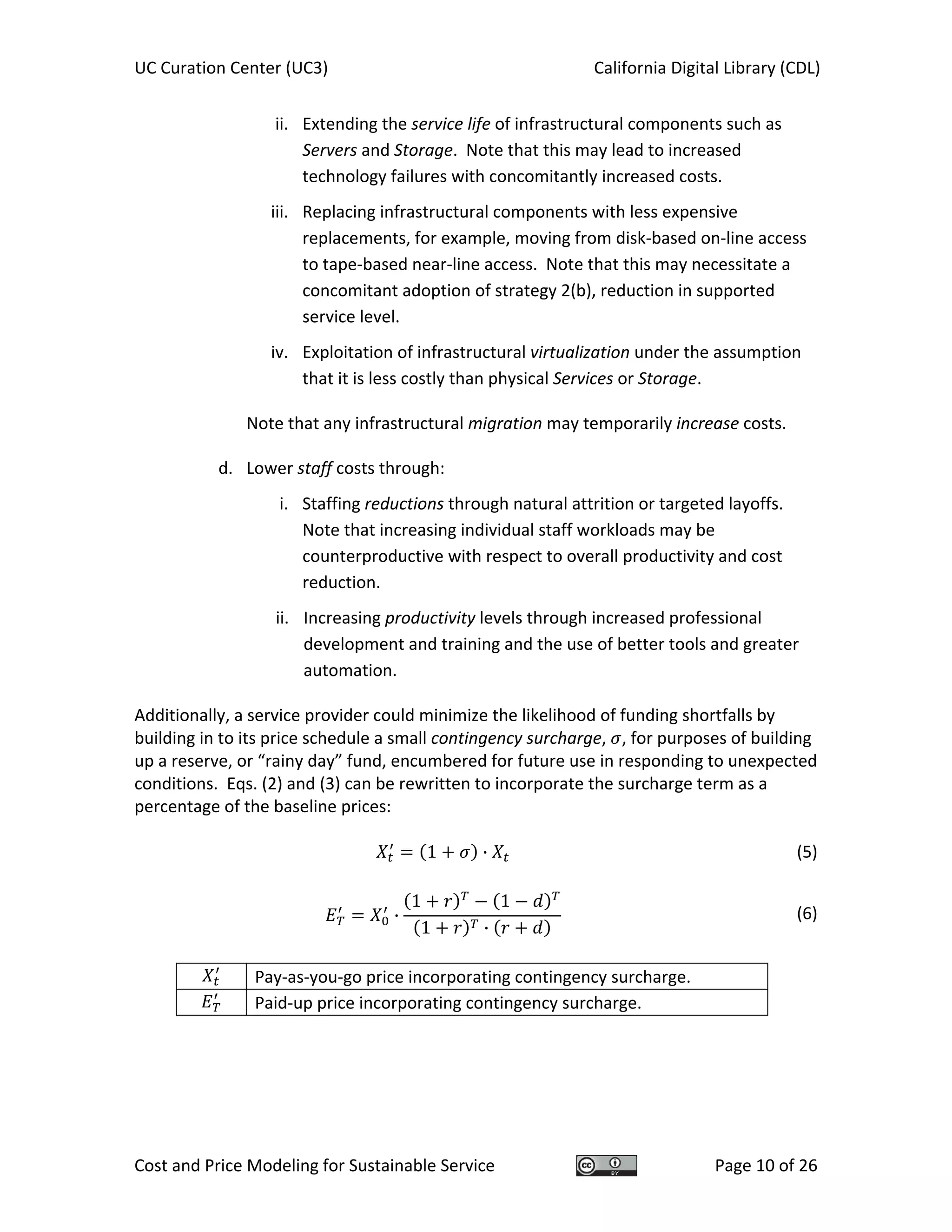
![UC Curation Center (UC3) California Digital Library (CDL)
Cost and Price Modeling for Sustainable Service Page 11 of 26
4 Conclusion
An understanding of the full economic costs of offering preservation and curation services
is necessary to the long‐term sustainability of those services and service providers. The
Total Cost of Preservation (TCP) model presented in this paper provides a useful analytical
framework for assessing and accounting for the full range of costs attendant to
preservation and curation services, and has been used to derive two price models: pay‐as‐
you‐go, which is most appropriate for customers with reliable and predictable sources of
continuing funding; and paid‐up, which is most appropriate for customers with term‐
limited funding.
The accompanying spreadsheet developed by UC3 to implement the TCP model is fully
parameterized and can be customized easily by other organizations to reflect local
conditions, assumption, policies, and policies [32].](https://image.slidesharecdn.com/xdtlxncersk4mrjbpvmz-140520031556-phpapp02/75/Tcp-cost-price-modeling-for-sustainable-services-v2-2-1-11-2048.jpg)
![UC Curation Center (UC3) California Digital Library (CDL)
Cost and Price Modeling for Sustainable Service Page 12 of 26
Appendix A Prior work
A number of international efforts have studied the question of long‐term preservation
costs; most notably, the Nationaal Archief of the Netherlands in 2005 [24]; the LIFE2
project (Life Cycle Information for E‐Literature) work on a Generic Preservation Model
(GPM) in 2008 [6][16][21]; the KRDS project (Keeping Research Data Safe) in 2010 [7][9];
the Princeton DataSpace initiative in 2010 [12][27]; the Danish National Archives and
Royal Library CMDP (Cost Model for Digital Preservation) in 2011 [11][19]; the ENSURE
project in 2011 [13]; the APARSEN project [3]; and the 4C project in 2013 [1]. (See [36]
for a summary of these and other relevant activities; see [22][26] for bibliographies of the
cost modeling literature.)
All of these models analyze preservation costs throughout the full lifecycle of preserved
assets. Both the Nationaal Archief and LIFE project work employ very fine‐grained
analysis of cost components and are based on representative actual costs rather than the
nominal costs employed by TCP. The LIFE model includes cost components for content
creation and acquisition, which are considered out of scope in the TCP analysis.
Furthermore, LIFE scales preservation action costs by the number of expected objects.
TCP assumes that there is no per‐object marginal cost; instead, marginal costs are
associated only with the various Content Types of which objects are members. The KRDS
model is specific to the research data lifecycle, but its findings appear to be applicable to
other contexts. Unlike the Nationaal Archief and LIFE models, KRDS assumes a
discounting function that annually decreases the aggregate cost of preservation service.
The DataSpace model is also based on a discounting function, but its analysis covers only
the costs associated with preservation storage, which are defined on a pay once, store
forever (POSF) basis. The OAIS activity‐based CMDP work concentrates on post facto
measuring of preservation costs, rather than on forecasting, although it is possible using
the framework. While DataSpace is explicitly concerned with “forever” pricing, neither it
nor any of the other models assume the benefit of an annual investment return in
offsetting a portion of ongoing costs. Most, if not all, of the individual cost components
of these models can be mapped to OAIS environmental and functional entities or TRAC
criteria [25], facilitating common points of reference and comparison. The APARSEN
project bases its work on the ISO 16363 standard for trusted digital repositories [19], a
formalization of TRAC. The ENSURE project has identified rigorous cost/benefit analysis
as a significant missing factor from most cost modeling efforts [36]. The 4C project has
also completed a comprehensive evaluation of a number of cost models [30] to identify
common characteristics and gaps in preparation of an economic sustainability reference
model [21].](https://image.slidesharecdn.com/xdtlxncersk4mrjbpvmz-140520031556-phpapp02/75/Tcp-cost-price-modeling-for-sustainable-services-v2-2-1-12-2048.jpg)
![UC Curation Center (UC3) California Digital Library (CDL)
Cost and Price Modeling for Sustainable Service Page 13 of 26
A number of institutions, both commercial and non‐profit/academic, now offer long‐term
preservation services. (Or at least persistent storage; the important distinction between
the two is not always apparent from the description of these service offerings.) Carbonite
is representative of commercial preservation service offerings. Its cost is $599/year for
up to 500 GB, with further increments of 100 GB available for $89/year. Amazon S3
pricing is complex, starting at $0.14/GB/month for the first TB with discounts for
additional amounts, and additional transactional charges for access [5]. The Amazon
Glacier service provides near‐line storage at a significantly discounted price of
$0.011/GB/month, with transaction frees being applied when access requests exceed a
5% monthly threshold [3]. The Chronopolis repository charges $1,500/TB/year [29]. The
Princeton DataSpace repository charges a one‐time fee of $0.006/MB [26]. The
DuraCloud service has a variety of price points ranging from $1,500/TB/year to
$6,900/TB/year for basic through enterprise service [12]. Note that these are the
baseline prices for the first TB, with a lesser rate for subsequent use and further price
decreases for content over 10 TB in size. The HathiTrust storage‐based pricing for
content‐contributing partners is $3.29/GB/year plus a one‐time fee of 25% the of the first
year cost [15]. The LifeTime Library at the University of North Carolina offers students
permanent storage “and associated services” for 250 GB, apparently with no associated
fees [33]. The USC Digital Repository offers a paid up license for 20 years of preservation
service for $1,000/TB [34]. In general, however, little information is available explaining
the basis of their business models.](https://image.slidesharecdn.com/xdtlxncersk4mrjbpvmz-140520031556-phpapp02/75/Tcp-cost-price-modeling-for-sustainable-services-v2-2-1-13-2048.jpg)
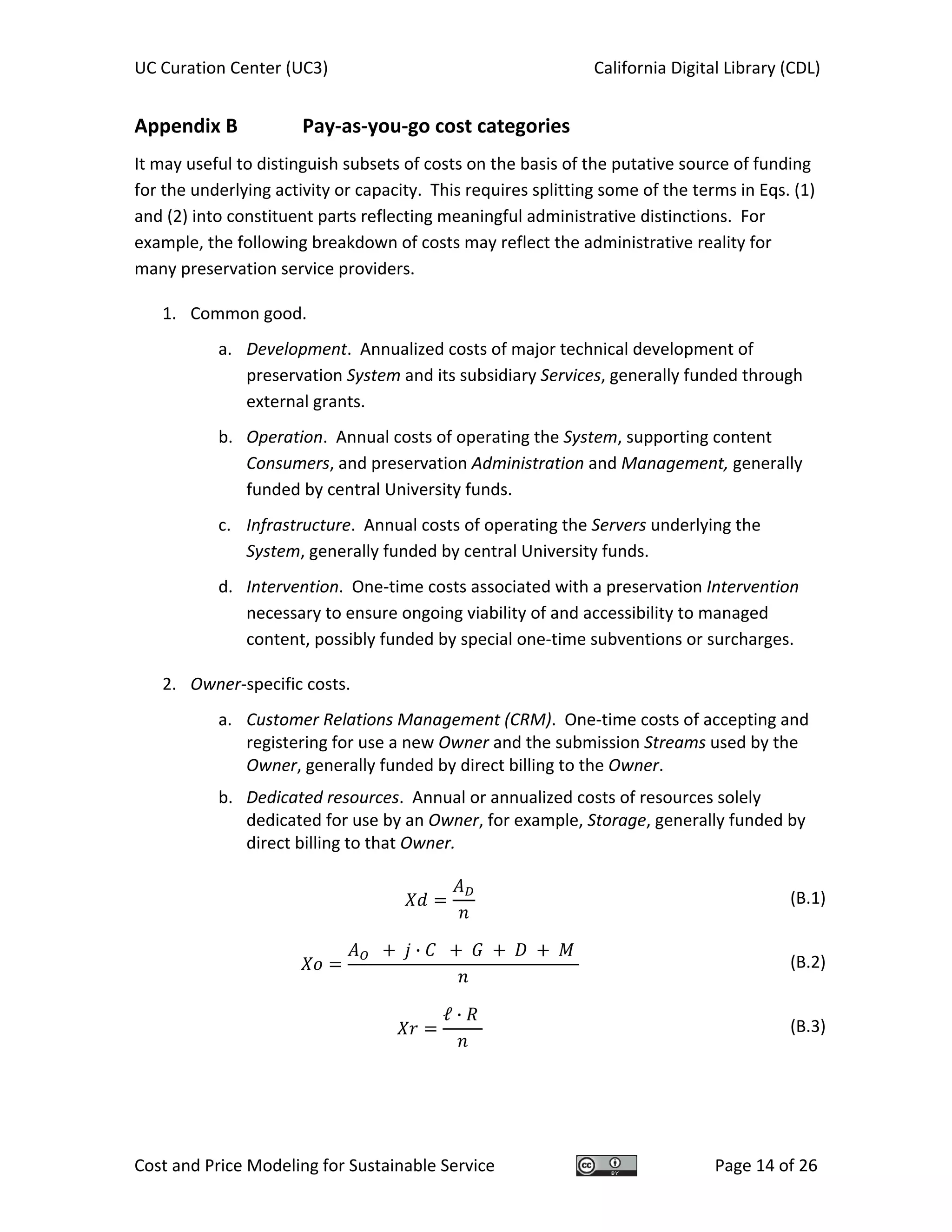
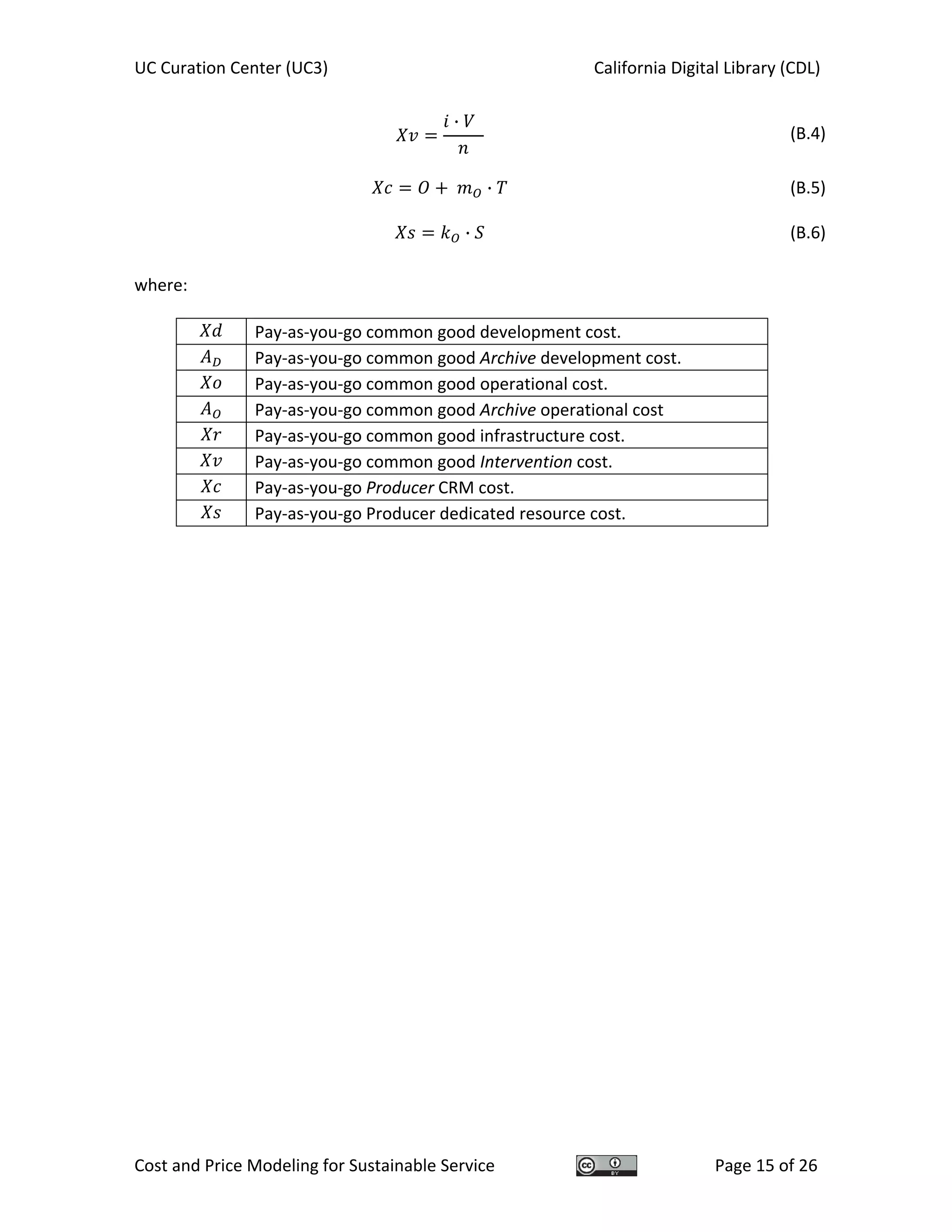

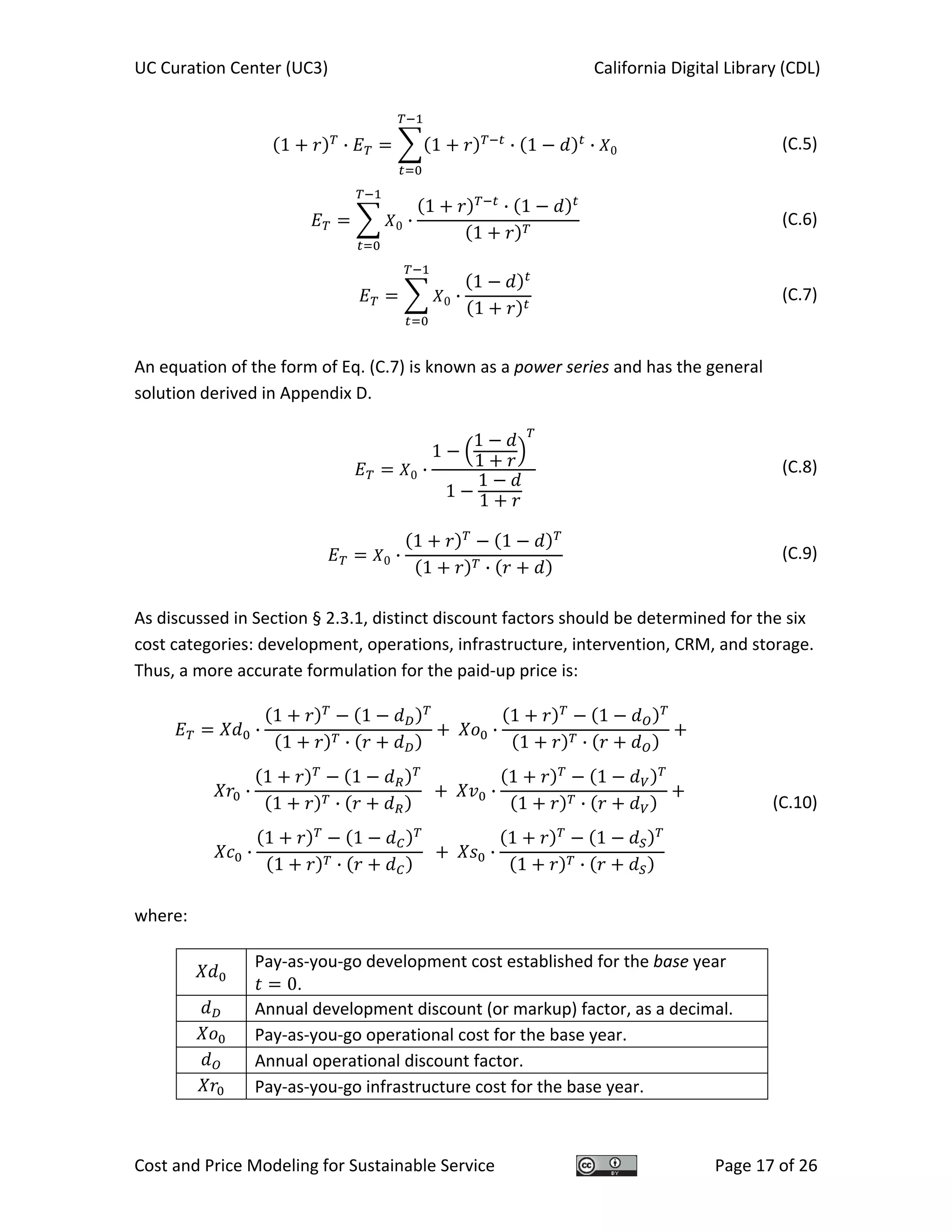

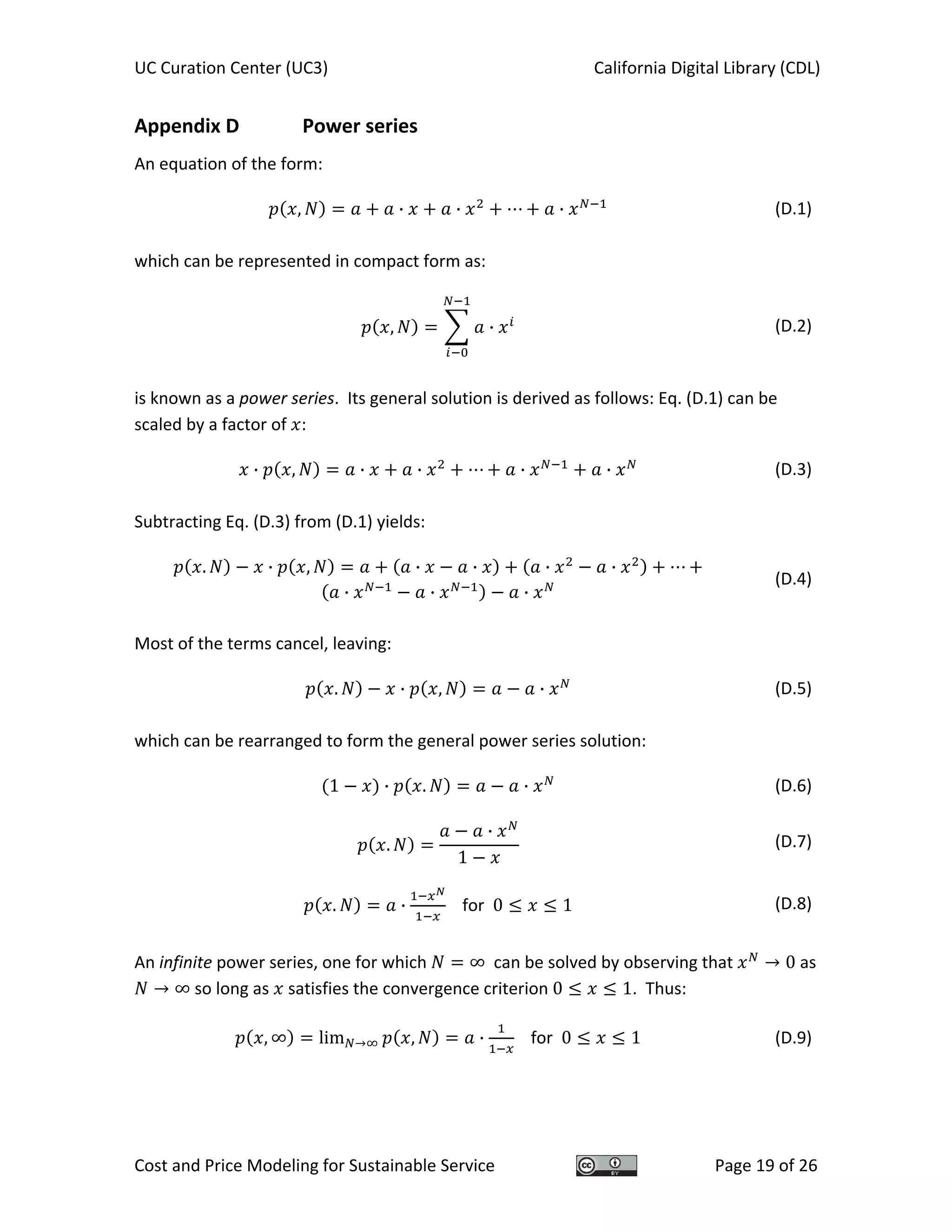
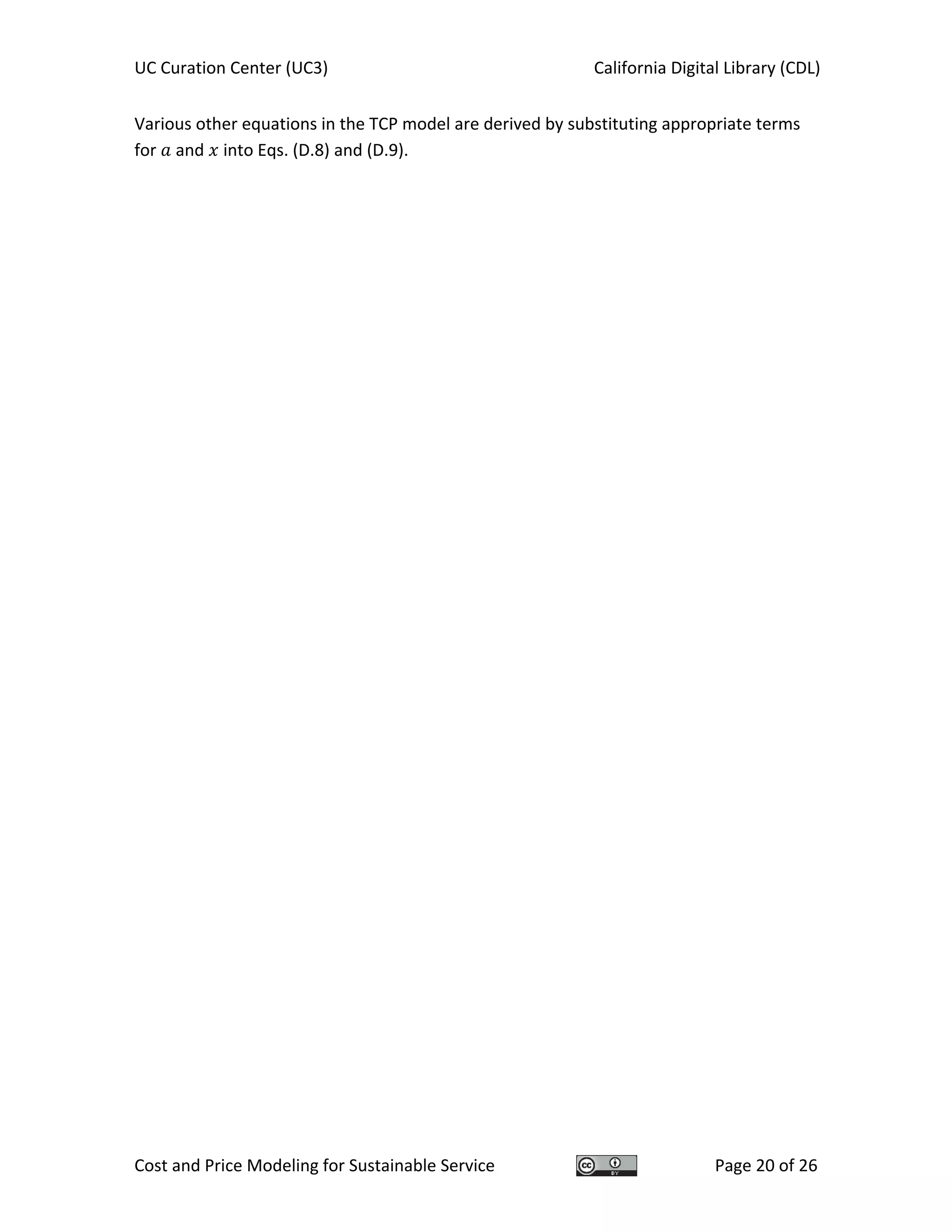
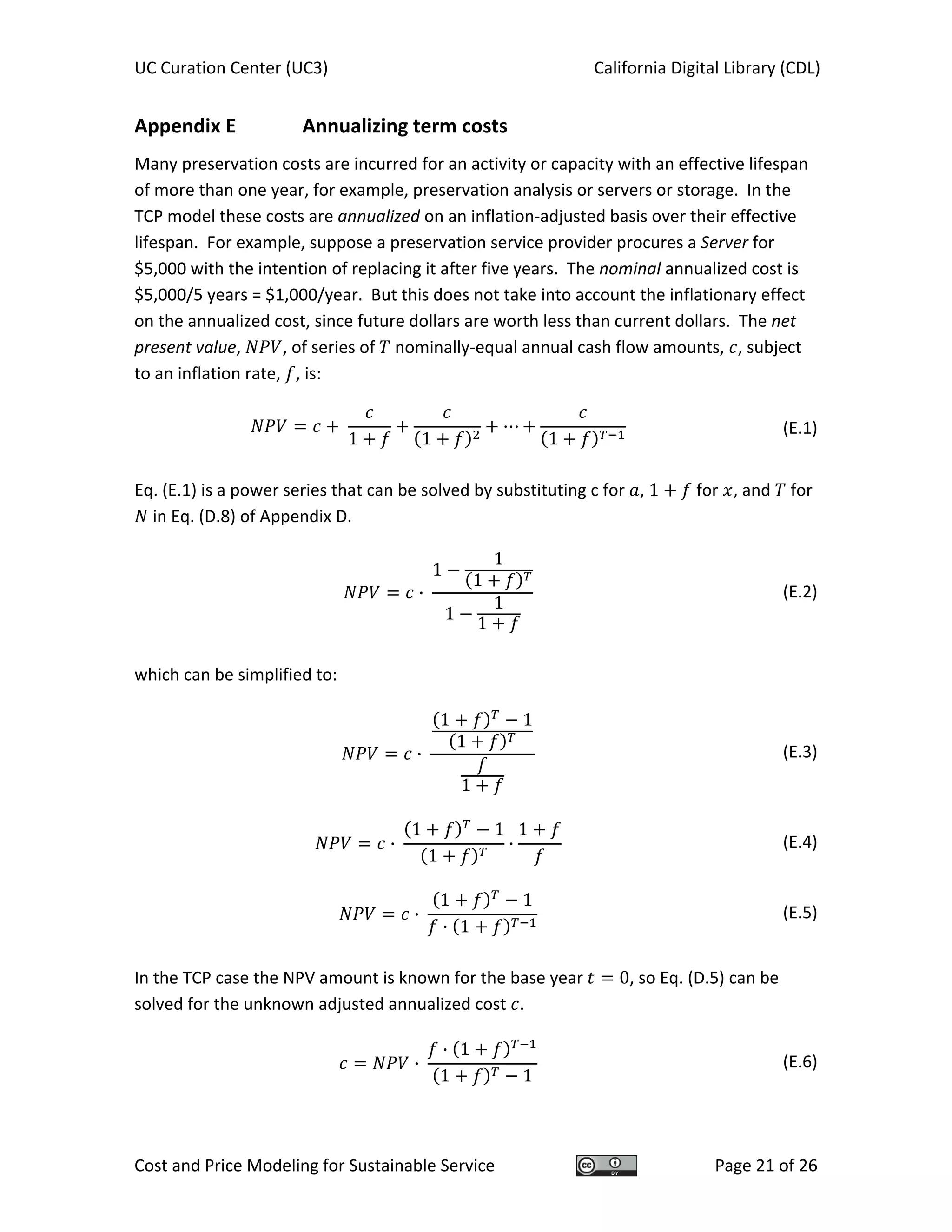
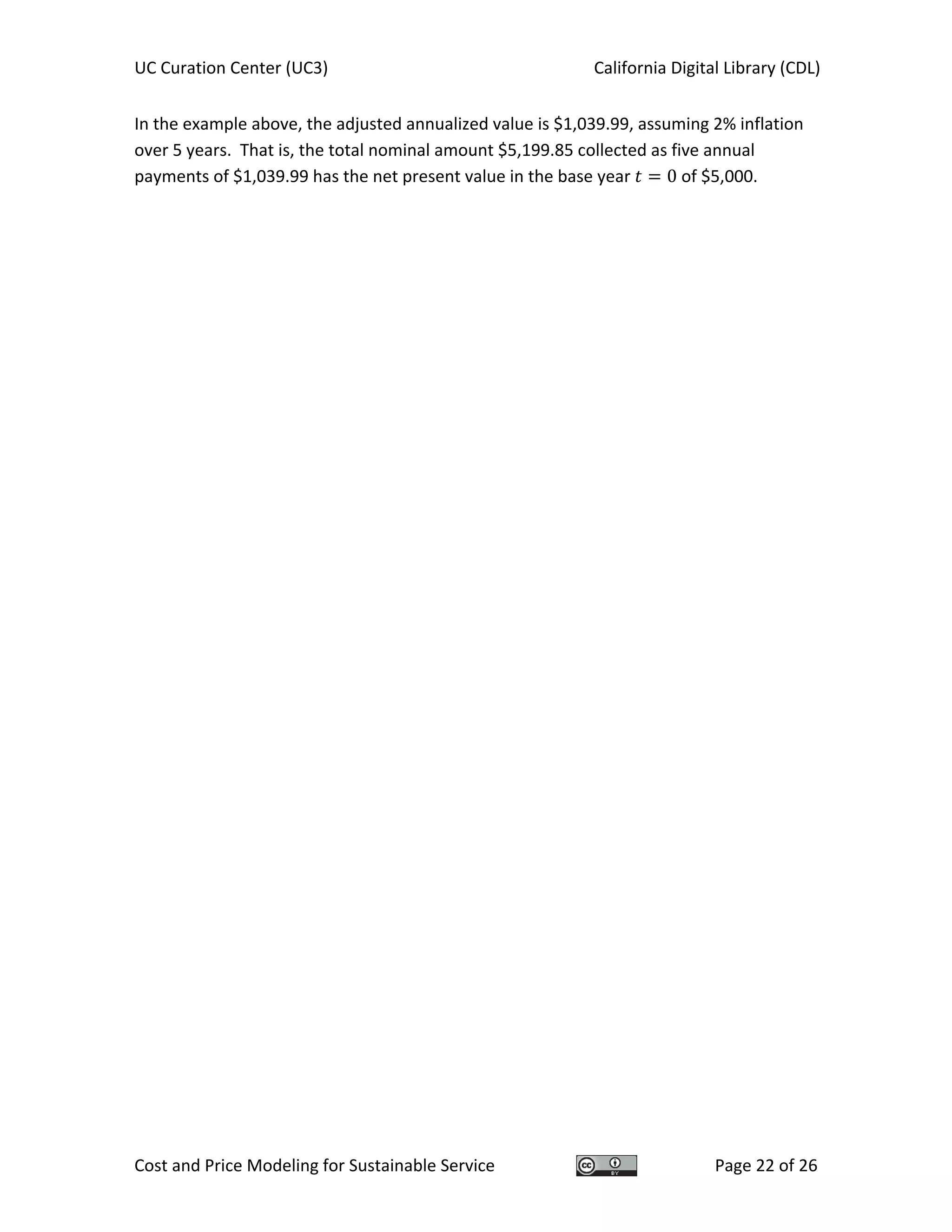
![UC Curation Center (UC3) California Digital Library (CDL)
Cost and Price Modeling for Sustainable Service Page 23 of 26
Appendix F Open Archival Information System (OAIS)
The ISO 14721 Open Archival Information System (OAIS) reference model provides a
useful reference for the development of a comprehensive archives “consisting of an
organization of people and systems that has accepted the responsibility to preserve
information and make it available for a Designated Community” [18].
The simplified OAIS entities and interactions used by TCP are depicted in Figures F.1 and
F.2.
Figure F.1 – High‐level OAIS entities and interactions
Figure F.2 – Intermediate OAIS entities and interactions
For purposes of accounting for and allocating the full economic cost of long‐term
preservation, the TCP model (see Figure 1) distinguishes between a narrowed System
entity, composed of the Ingest, Data management, and Access services, and the Servers
or infrastructural platform on which the System operates and the Storage that the
preserved content occupies.](https://image.slidesharecdn.com/xdtlxncersk4mrjbpvmz-140520031556-phpapp02/75/Tcp-cost-price-modeling-for-sustainable-services-v2-2-1-23-2048.jpg)
![UC Curation Center (UC3) California Digital Library (CDL)
Cost and Price Modeling for Sustainable Service Page 24 of 26
References
[1] 4C Project (2013), 4C: Collaboration to Clarify the Cost of Curation
<http://www.4cproject.eu/>.
[2] Addis, Matthew (2012), “Cost modeling for forever storage,” PASIG 2012, Dublin, October
16‐19.
[3] Alliance for Permanent Access (2012), Report on Cost Parameters for Digital Repositories
<http://www.alliancepermanentaccess.org/wp‐content/uploads/downloads/2013/03/
APARSEN‐REP‐D32_1‐01‐1_0.pdf>.
[4] Amazon, Amazon Glacier Pricing, accessed 2012‐11‐02
<http://aws.amazon.com/glacier/pricing>.
[5] Amazon, Amazon S3 Pricing, accessed 2012‐11‐02 <http://aws.amazon.com/s3/pricing>.
[6] Ayris, Paul, Richard Davies, Rory McLeod, Rui Miao, Helen Shenton, and Paul Wheatley
(2008), LIFE2 Final Project Report, <http://eprints.ucl.ac.uk/11758>.
[7] Beagrie, Neil, Brian Lavoie, and Matthew Woollard (2010), Keeping Research Data Safe 2
<http://www.jisc.ac.uk/media/documents/publications/reports/2010/keepingresearchda
tasafe2.pdf>.
[8] California Digital Library (2012), California Digital Library <http://www.cdlib.org/>.
[9] Charles Beagrie (2011), Keeping Research Data Safe (KRDS)
<http://www.beagrie.com/krds.php>.
[10] Damodaran, Aswath (2002), Investment Valuation: Tools and Techniques for Determining
the Value of Any Asset (2n ed.; New York, Wiley).
[11] Danish National Archives/Danish Royal Library (2011), Cost Model for Digital Preservation
(CMDP) <http://www.costmodelfordigitalpreservation.dk/>, accessed 2011‐09‐02. See
also, <http://www.costmodelfordigitalpreservation.dk/contact/cmdp‐1‐‐‐preservation‐
planning‐and‐digital‐
migrations/documentation/Kostenmodel_in_Excel_versie_1.2_%28final%29.xls> and
<http://www.costmodelfordigitalpreservation.dk/contact/cmdp‐2‐‐‐ingest‐and‐archival‐
storage/documentation/Tool_Version_2.xls>.
[12] DuraSpace (2012), DuraCloud Subscription Plans, accessed 2012‐11‐02
<http://www.duracloud.org/pricing>.
[13] ENSURE project (2011), ENSURE – Enabling Knowledge Sustainability, Usability, and
Recovery for Economic Value <http://ensure‐fp7‐plone.fe.up.pt/site>.
[14] Goldstein, Serge J., and Mark Ratliff (2010), DataSpace: A Funding and Operational Model
for Long‐Term Preservation and Sharing of Research Data,
<http://arks.princeton.edu/ark:/88435/dsp01w6634361k>.](https://image.slidesharecdn.com/xdtlxncersk4mrjbpvmz-140520031556-phpapp02/75/Tcp-cost-price-modeling-for-sustainable-services-v2-2-1-24-2048.jpg)
![UC Curation Center (UC3) California Digital Library (CDL)
Cost and Price Modeling for Sustainable Service Page 25 of 26
[15] HathiTrust (2012), Cost <http://www.hathitrust.org/cost>.
[16] Hole, Brian, Li Lin, Patrick McCann, and Paul Wheatley (2010), “LIFE3
: A predictive costing
tool for digital collections,” 7th International Conference on Preservation of Digital Objects
(iPRES2010), Vienna, September 19‐24, 2010
<http://www.life.ac.uk/3/docs/Ipres2010_life3_submitted.pdf>.
[17] Intel Corporation (2005), A Conversation with Gordon Moore: Moore’s Law
<ftp://download.intel.com/museum/Moores_Law/Video‐
Transcripts/Excepts_A_Conversation_with_Gordon_Moore.pdf>.
[18] ISO 14721 (2003), Space data and information transfer systems – Open archival
information system – Reference model. See also, CCSDS 650.0‐B‐1 (2002), Blue Book
<http://public.ccsds.org/publications/archive/650x0b1.pdf>.
[19] ISO 16363 (2012), Space data and information transfer systems – Audit and certification of
trustworthy digital repositories <http://public.ccsds.org/publications/archive/
652x0m1.pdf>.
[20] Kejser, Ulla Bøgvad, Anders Bo Nielsen, and Alex Thirifays (2011), “Cost model for digital
preservation: Cost of digital migration,” International Journal of Digital Curation 6(1): 255‐
267 <http://www.ijdc.net/index.php/ijdc/article/viewFile/177/246>.
[21] Lavoie, Brian, and Neil Grindley (2013), A Draft Economic Sustainability Reference Model
<http://www.4cproject.eu/component/docman/doc_download/32‐ms9‐draft‐esrm>.
[22] Library of Congress (2012), "A digital asset sustainability and preservation cost
bibliography," The Signal: Digital Preservation
<http://blogs.loc.gov/digitalpreservation/2012/06/a‐digital‐asset‐sustainability‐and‐
preservation‐cost‐bibliography/>.
[23] LIFE project (2011), LIFE: Life Cycle Information for E‐Literature <http://www.life.ac.uk/>.
[24] Nationaal Archief (2005), Costs of Digital Preservation,
<http://www.nationaalarchief.nl/sites/default/files/docs/kennisbank/codpv1.pdf>,
accessed 2011‐09‐02. See also,
<http://www.nationaalarchief.nl/sites/default/files/docs/kennisbank/kostenmodel_in_ex
cel_versie_1.2_final.xls>.
[25] OCLC/Center for Research Libraries (2007), Trusted Repository Audit & Certification:
Criteria and Checklist <www.crl.edu/sites/default/files/attachments/pages/trac_0.pdf>.
[26] Open Planets Foundation (2013), Digital Preservation and Data Curation Costing and Cost
Modeling <http://wiki.opf‐labs.org/display/CDP/Home>.
[27] Princeton University (2009), DataSpace Policies and Guidelines, July 15
<http://dataspace.princeton.edu/jspui/about/DataSpacePnG.pdf>.
[28] Rosenthal, David S. H., Daniel C. Rosenthal, Ethan L. Miller, Ian F. Adams, Mark W. Storer,
and Erez Zadok (2012), “The economics of long‐term digital storage,” Memory of the](https://image.slidesharecdn.com/xdtlxncersk4mrjbpvmz-140520031556-phpapp02/75/Tcp-cost-price-modeling-for-sustainable-services-v2-2-1-25-2048.jpg)
![UC Curation Center (UC3) California Digital Library (CDL)
Cost and Price Modeling for Sustainable Service Page 26 of 26
World in the Digital Age: Digitization and Preservation, Vancouver, September 26‐28,
2012 <http://www.lockss.org/locksswp/wp‐content/uploads/2012/09/unesco2012.pdf>.
[29] San Diego Supercomputer Center, Chronopolis Pricing, accessed 2012‐11‐02
<http://chronopolis.sdsc.edu/pricing>.
[30] Stokes, Paul, ed. (2014), Evaluation of Cost Models and Needs & Gap Analysis
<http://www.4cproject.eu/component/docman/doc_download/34‐d3‐1‐evaluation‐of‐
cost‐models‐and‐needs‐gaps‐analysis?Itemid=>.
[31] University of California Curation Center (2012), University of California Curation Center
<http://www.cdlib.org/uc3>.
[32] University of California Curation Center (2012), Cost Modeling
<https://confluence.ucop.edu/display/Curation/Cost+Modeling>.
[33] University of North Carolina (2011), Life Time Library thought to be the first nationwide,
September 15, 2011 <http://sils.unc.edu/news/2011/SILS‐lifetime‐library>.
[34] University of Southern California (2011), USC Digital Repository: Pricing
<http://repository.usc.edu/pricing/>.
[35] Walter, Chip (2005), “Kryder’s law,” Scientific American 293 (July 25): 32‐33
<http://www.scientificamerican.com/article.cfm?id=kryders‐law >.
[36] Xue, Pengfei, Mohamed Badawy, Essam Shehab, and Paul Baguley (2011), "Cost modeling
for long‐term digital preservation: Challenges and issues," 9th International Conference on
Manufacturing Research,
[37] Zeller, Jean‐Daniel (2010), “Cost of digital archiving: Is there a universal model?” 8th
European Conference on Digital Archiving, Geneva, April 28‐30, 2010
<http://regarddejanus.files.wordpress.com/2010/05/costsdigitalarchiving‐
_jdz_eca2010.pdf>.](https://image.slidesharecdn.com/xdtlxncersk4mrjbpvmz-140520031556-phpapp02/75/Tcp-cost-price-modeling-for-sustainable-services-v2-2-1-26-2048.jpg)